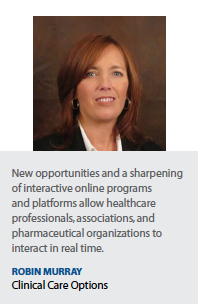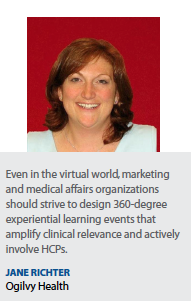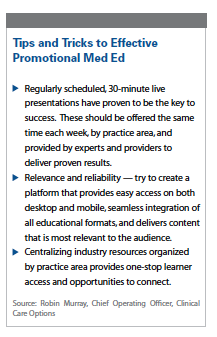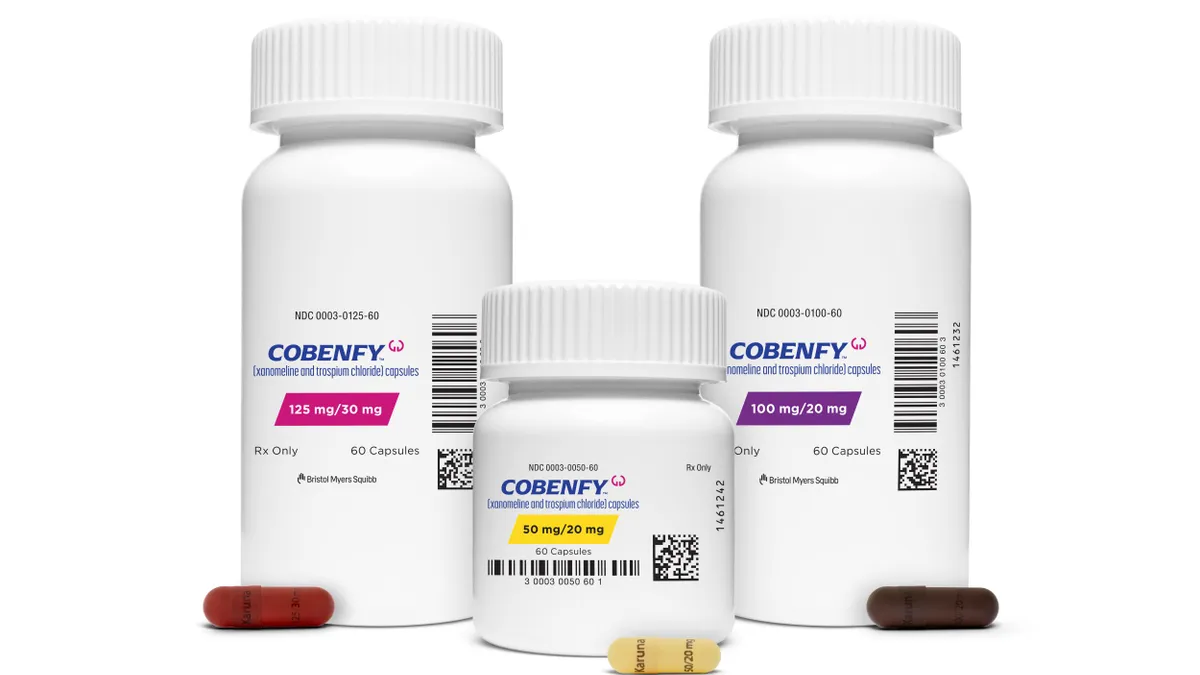With all medical education forced to go virtual, the industry has been working hard to ensure peer-to-peer engagements cut through the clutter.
 For the past year, all forms of learning have been forced to go virtual. For the pharmaceutical industry and associations managing non-accredited medical education, the challenge has been compounded by the fact that healthcare professionals are spending their lives in virtual meetings.
For the past year, all forms of learning have been forced to go virtual. For the pharmaceutical industry and associations managing non-accredited medical education, the challenge has been compounded by the fact that healthcare professionals are spending their lives in virtual meetings.
From telemedicine engagement with their patients to countless online advisory boards, steering committees, congress meetings, symposia, education programs, and sessions on independent educational sites, HCPs have become “zoomed out," experts say.
“We went from traveling to ASCO, ACC, and other national conferences and regional meetings to no travel," says Robin Murray, chief operating officer, Clinical Care Options. “We all had to embrace web-based platforms, even for day-to-day operations in our organizations. It was interesting to watch and participate in the complete shift of engagement style."
According to Jane Richter, executive VP, account management for the medical education group at Ogilvy Health, medical education not only had to change, but had to do so at warp speed, in much the same way as the COVID-19 vaccine program.
 “Medical education had to jump on the warp speed bandwagon and kick into high gear to redesign peer-to-peer educational plans, accelerate the development of unique virtual programs, and leverage new technologies and innovative platforms to make programs even more interactive," Ms. Richter says. “As the pandemic progressed and virtual fatigue set in, the biggest challenge became how to make virtual, peer-to-peer engagements cut through the virtual clutter that is bombarding our pharmaceutical audiences every day."
“Medical education had to jump on the warp speed bandwagon and kick into high gear to redesign peer-to-peer educational plans, accelerate the development of unique virtual programs, and leverage new technologies and innovative platforms to make programs even more interactive," Ms. Richter says. “As the pandemic progressed and virtual fatigue set in, the biggest challenge became how to make virtual, peer-to-peer engagements cut through the virtual clutter that is bombarding our pharmaceutical audiences every day."
Success in this more complex environment meant setting clear educational goals, having confidence in the ability to achieve those, and being flexible and creative about the approach, Ms. Richter says.
Logistical considerations are also key. Ms. Murray says the focus has shifted to details such as whether the platform is accessible without downloading new software or an app, how many people can participate as faculty at one time, can participants submit questions, and is it possible to do polling questions.
“All types of technologies are being combined with traditional and nontraditional approaches, with the objective of learning how to better increase message retention and make programs more memorable," Ms. Richter says.
A Technology Evolution
While COVID-19 has been a catalyst for rapid change, technology and innovative digital approaches for promotional med ed have been evolving over several years as busy HCPs have sought to move away from traditional in-person meetings with sales reps, while still ensuring they gain insights into new medicines. Companies have also been evolving their scientific storytelling to show how a product will influence a patient’s whole treatment experience.
 Ms. Richter says that over the past 12 months there has been a greater need for innovative digital technologies and new approaches to storytelling to come together to capture the attention of the audience, sustain engagement, and elevate the educational experience.
Ms. Richter says that over the past 12 months there has been a greater need for innovative digital technologies and new approaches to storytelling to come together to capture the attention of the audience, sustain engagement, and elevate the educational experience.
“We’ve seen an increase in the use of cutting-edge virtual platforms for live interactions with more unique features for communications beyond the typical, simple webinar with webcams," she says. “One relatively new meeting technology platform integrates face-to-face communication, with a newscast production feel using tools to create lean-in engagement. Participants have responded well to the dynamic, broadcast quality that allows for an interesting combination of presenter and participant exchanges."
Other technologies Ogilvy Health is seeing come to the fore include the use of digital tools to facilitate interaction, including virtual whiteboards, which are helping to build greater engagement within advisory boards.
“Many of our clients are finding the asynchronous virtual advisory board platforms to be a valuable option to engage with HCPs for gathering insights on key topics, presenting data for in-depth discussion, and sharing materials to vet clinical relevance," Ms. Richter says. “Not only do these platforms offer a low- cost, convenient option allowing HCPs to engage when it’s convenient for their schedules, but it also can provide great opportunities to engage in between live virtual events as well."
Ms. Murray highlights several approaches that are gaining ground in medical education. Microlearning offers smaller chunks of critical medical updates, providing more flexibility for busy HCPs, she says.
 “There is now greater diversity in educational programs and formats, providing options and platforms that serve live interactions, multi-formatted resources, articles and updates from the field, provided by practice area," Ms. Murray says. “Improving technologies also ensure the best learner experience, based on his or her needs and interests, served on platforms that are intuitive and match learners with the right education."
“There is now greater diversity in educational programs and formats, providing options and platforms that serve live interactions, multi-formatted resources, articles and updates from the field, provided by practice area," Ms. Murray says. “Improving technologies also ensure the best learner experience, based on his or her needs and interests, served on platforms that are intuitive and match learners with the right education."
Weighing the Benefits
With uncertainty as to when in-person events will be possible, organizations have had to adapt in ways that could potentially change the landscape long-term, experts say.
“New opportunities and a sharpening of interactive online programs and platforms allow healthcare professionals, associations, and pharmaceutical organizations to interact in real time," Ms. Murray says. “Another advantage is that virtual makes it possible to support organizations that would otherwise have limited means to connect with healthcare professionals, top healthcare experts and providers, and has proven to be a winning combination."
However, the importance of physical touch cannot be overlooked, Ms. Richter notes. “If there is one thing that I’ve learned during the pandemic, it’s that I’ve never seen more excitement gleaned from the receipt of an Amazon package, and we’ve never before argued to see who would get to run out to the street for the mail," she says. “We’ve had a lot of success with bringing back that physical touch to our programming, including pre-event mailings delivering engaging content, materials for interactive exercises during the meeting, and post-event mailings to reinforce concepts and continue the conversation."
She adds that QR codes are also making a comeback, which underscores the importance of using personal devices in tandem with virtual programming to create new and interesting interactions, as well as reinforce educational content.
Even in the virtual world, marketing and medical affairs organizations should strive to design 360-degree experiential learning events that amplify clinical relevance and actively involve HCPs throughout the learning experience, whether short or long format, Ms. Richter says.
“It should also be an experience that infuses behavior science to initiate behavior change, incorporates adult learning principles to optimize retention, but, more importantly, creates a long-lasting memory about which HCPs will tell their colleagues," she says. “More authentic storytelling can help achieve this as it keeps audiences connected to the content being conveyed. It can aid in evoking a strong emotional response, or perhaps make the topic more relatable, resulting in better retention, more motivation to learn, greater interest, and increased likelihood to share the information with colleagues. It’s important to be thoughtful about the language and visuals we use to support the story we are telling so it is easy to understand and is appropriate for the audience. Also, selecting well-respected experts who are comfortable delivering an educational message in the virtual world is critical."(PV)



















